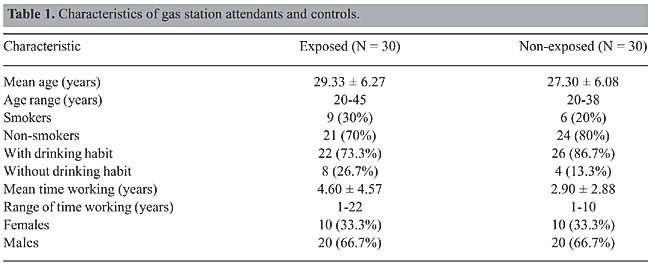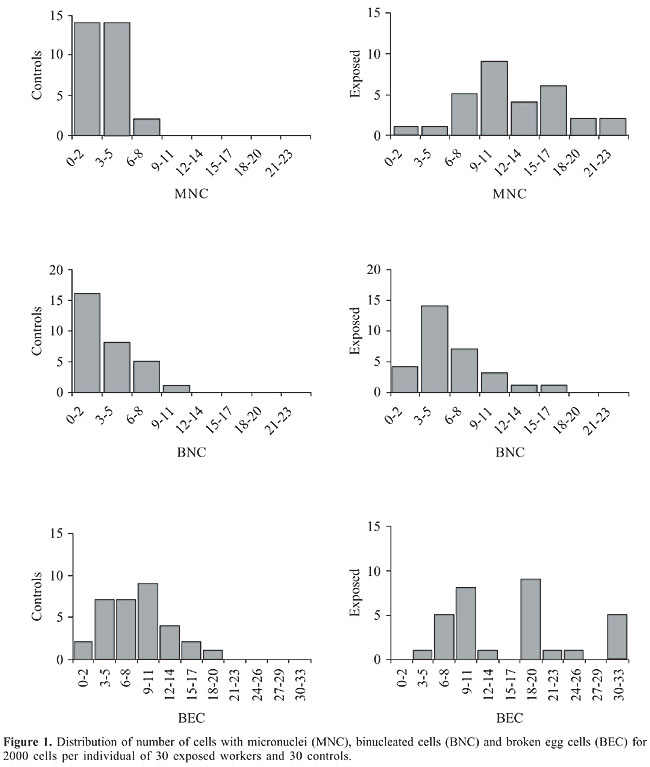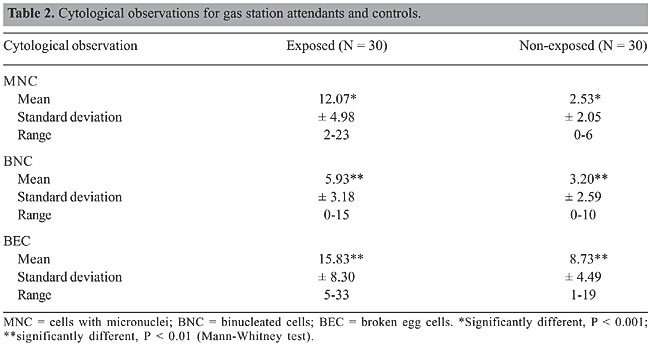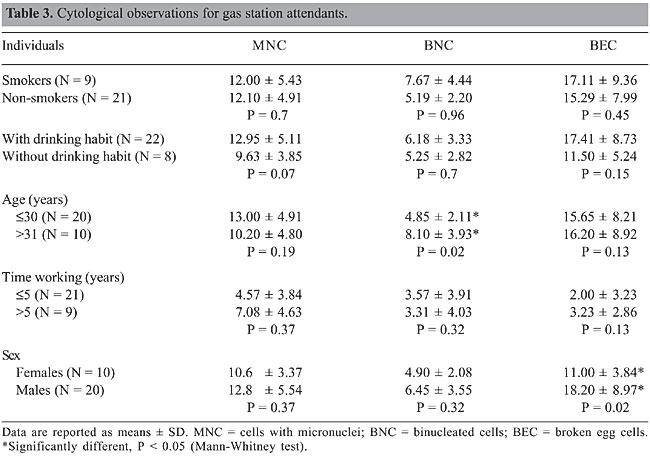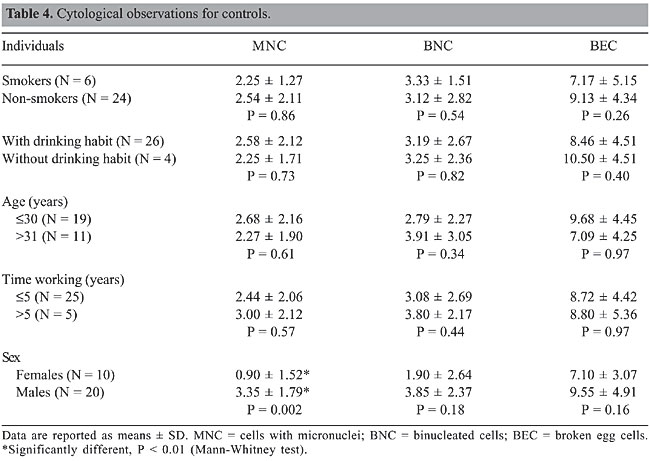
ABSTRACT. In the present study, the micronucleus test was applied in exfoliated cells of buccal mucosa to assess the mutagenicity risk associated with occupational exposure for gas station attendants. For each individual, 2000 exfoliated buccal cells were analyzed for micronucleus frequency. A highly significant difference was found between exposed and control groups. Likewise, a significant difference was found between these groups regarding the frequency of binucleated and broken egg cells. To determine whether smoking, alcohol habit, age, gender, or working time could exert any additional effect, we determined the frequency of micronuclei and binucleated and broken egg cells amongst exposed and control individuals. The results allowed us to conclude that the individuals studied belong to a risk group and should periodically undergo biological monitoring and appropriate care. Key words: Micronucleus test, Mutagenicity, Occupational exposure, Gas station attendants, Exfoliated cells, Biological monitoring INTRODUCTION Millions of workers in a variety of occupational settings have the potential to be exposed to hazardous substances. These substances, including dust particles, fibers and organic or inorganic chemicals, are raw materials, intermediates, by-products, or end-products in industrial processes. They can be present in the occupational environment in the form of gases, vapors, fumes, mist, or particles. Inhalation is the first route of exposure; however, exposure can also take place through dermal absorption or ingestion. Most workers are exposed to complex chemical mixtures, and illness in some of them can be attributed to exposure to these substances (Keshava and Ong, 1999). Petroleum derivate compounds constitute a complex mix of chemicals, some of them well-known genotoxic agents (Pitarque et al., 1997). According to the International Agency for Research on Cancer (IARC), the exposure to gasoline vapors is classified as carcinogenic to humans, especially on the basis of the well-established carcinogenicity of some components such as benzene (Carere et al., 1995). Gas station workers who pump gasoline are liable to absorb not only the products present in the fuel fumes, but also the products emitted by engines (Santos-Mello and Cavalcante, 1992). This exposure can increase the risk (alternatively:sensitivity) to the development of several types of cancer, such as urinary tract, skin, laryngeal and pancreatic cancers, and leukemias. The influence of fuel composition on the mutagenicity of gasoline has been addressed in several investigations. These studies indicate a lower emission of mutagenic substances with alcohol blends, and a positive correlation between the aromatic content of gasoline and its mutagenicity (Crebelli et al., 1995). Grandjean and Andersen (1991) found a direct correlation between cancer and occupational exposure, and reported that lung cancer is the major cause of death among workers chronically exposed to petroleum derivates. Considering that occupational exposure to such substances may have hazardous effects, we investigated the possible mutagenicity risk among pump attendants, by quantitative determination of cells with micronuclei (MNC) and binucleated (BNC) and broken egg cells (BEC). MATERIAL AND METHODS Subjects The frequency of MNC and BNC and BEC was investigated in 2000 exfoliated cells from the buccal mucosa of each individual. The study sample was composed of 20 male and 10 female gas station attendants of Pelotas, RS, Brazil, employed to pump fuel and 30 controls. Exposed and control individuals were matched according to sex and social-economic status. All subjects were interviewed to evaluate their habits, according to the protocol published by the International Commission for Protection against Environmental Mutagens and Carcinogens (Carrano, 1988). Cytological preparations The oral mucosa was washed before the buccal cells were collected. The mucosa was then swabbed with a moistened wooden tongue depressor. For each individual, two slides were prepared by smearing the cells onto pre-cleaned slides. The slides were then air-dried, fixed with methanol, stained by the Feulgen reaction, and counterstained with fast-green, as previously described (Stich and Rosin, 1982). Coded slides were analyzed using a light microscope, at 1000X magnification. A total of 2000 cells from each individual were examined, and the results were reported as the frequency of cells with MNC and BNC, and BEC. Statistical analysis A total of 2000 cells were inspected per individual (30 exposed workers and 30 controls), that is, a total of 60,000 in each group or 120,000 cells altogether. The sample number of 2000 cells should give an untruncated distribution of MNC, BNC and BEC events. The independent variable (sex) was classified as qualitative (nonparametric). The role of nonparametric factors was analyzed by the Mann-Whitney test, while the Student t-test was used for age and time comparisons. The MNC, BNC and BEC distributions of individuals, grouped by each of two-class factors, were compared with the Mann-Whitney test. Associations between independent variables and the occurrence of MNC, BNC and BEC were measured by nonparametric Spearman rank correlation coefficients. The null hypothesis was rejected at 5% level of significance. RESULTS The averages for age and time working in years, and the sex of 30 exposed and 30 control individuals are reported in Table 1.
The absolute frequency of cells with MNC and BNC and BEC among 2000 cells of each individual of both groups is shown in Figure 1. Thirty percent of the controls had no cells with micronuclei, and only 32.3% of them showed 1 to 3 cells with micronuclei, resulting in multiple modes (0-2 and 3-5 MNC). The maximum number of MNC was six among non-exposed individuals. On the other hand, we found a variable distribution of the cells with micronuclei among exposed individuals, ranging from 2 to 23 MNC, resulting in class mode 9-11 MNC.
The distribution of the number of BNC obtained was different between the control and exposed groups. In the control group, 56.7% showed 0-3 BNC, resulting in a class mode of 0-2, while in the exposed group only 13.3% showed this number of BNC. Among control individuals, 76.7% had 11 BEC, the maximum number found, whereas in the exposed group, only 46.7% showed this same number. The mode in the control group was the 9-11 class, and in the exposed individuals it was the 18-20 BEC class. Table 2 shows the data regarding the mean numbers of MNC, BNC and BEC of both exposed and non-exposed individuals included in this investigation. Regarding the micronucleus frequency, a highly significant difference (P < 0.001) was found between exposed and control groups, and a significant difference (P < 0.05) regarding the frequency of BNC and BEC. All analyses were performed using the Mann-Whitney test.
The effect of age (within the following intervals: £30 and >31 years) on the frequency of micronucleated cells was investigated, among both exposed and controls through Mann-Whitney test, and no associations were observed between age and petroleum exposure (Tables 3 and 4). Likewise, we did not detect any relation between nuclear abnormalities and time working (£5 and >5 years), in both exposed and control groups.
The frequency of MNC, BNC and BEC was compared between males and females, in both exposed and control individuals. Interestingly, only in the control group did males show at least three more cells with micronuclei than females (Table 4). The Spearman correlation coefficients between MNC and sex were significant at the 0.01 level. Based on the P values estimated by Spearman rank coefficients, the main factor associated with increased frequency of MNC in exfoliated cells was sex, within the control group. DISCUSSION Exposure to genotoxic agents can result from natural and environmental factors, non-specific contamination, occupational environment, or industrial accidents (Anderson, 1999). Gas station attendants are exposed to gases produced by fuel combustion and to the fumes of the fuel itself. The exposure to motor vehicle emissions represents an important cause of concern because of its possible long-term effects on human health. A number of experimental studies, as well as epidemiological evidence, indicate that gasoline and diesel engine exhausts are mutagenic and carcinogenic to laboratory animals and possibly to humans (Crebelli et al., 1995). Whereas Fredga et al. (1979) failed to detect an increased frequency of chromosome aberrations among Swedish pump attendants, Hogstedt et al. (1991) detected a significant increase in the frequency of micronuclei in pokeweed mitogen-stimulated lymphocytes from gas pump mechanics, and Santos-Mello and Cavalcante (1992) detected a significant increase in chromosome deletions. The present study carried out in Brazilian (Pelotas, RS) pump attendants showed a significant increase in the frequency of MNC, BNC and BEC among these workers. This increased number of nuclear abnormalities could be the result of the attendant’s continuous absorption of the bath: the fumes emitted by the fuel, which contain genotoxic substances such as benzene, and the engine emission products of the vehicles, which are constantly stopping to refuel at the station. Huisingh (1980) noted that emissions resulting from the internal combustion of automobile engines consist of thousands of different compounds. Furthermore, these emission products also have cytotoxic and genotoxic properties, as demonstrated by Hadnagy and Seemayer (1988). Confounding factors affect responses in all cell types. There are endogenous confounding factors such as age, sex, genetic make-up, and exogenous confounding factors, including life style habits. There are biomarkers of exposure, effect, and susceptibility. In addition, individual susceptibility could be influenced by the genotype and polymorphisms in genes existing in a population (Anderson, 1999). Lifestyle factors are estimated to be responsible for about 80% of human neoplasias. Among the different avoidable risks, the consumption of tobacco and alcohol is directly linked to an elevated incidence of several forms of cancer (Majer et al., 2001). However, the results of different studies are controversial. In some reports, such as Sarto et al. (1987) and Burgaz et al. (1995), no genotoxic effect was found in individuals with an alcohol habit. In contrast, Stich and Rosin (1983) demonstrated a synergistic effect of alcohol and nicotine in their results. In the present study, we observed a small and non-significant increase in MNC, BNC and BEC, among exposed individuals with an alcohol habit. However, in the control group alcohol habit was not shown to be associated with nuclear alterations. Tobacco smoking is the most important and well-documented cause of cancer currently known, and epidemiological studies have linked it to cancers of the lung, mouth, pharynx, esophagus, kidney, bladder, pancreas, and cervix (Burgaz et al., 1995). Studies based on the genotoxic effects of tobacco alone fall into three categories according to the form of consumption (chewing, snuffing, and smoking). The micronucleus frequency in the oral mucosa cells of cigarette smokers was generally lower than that detected in cells of tobacco chewers (Stich and Rosin, 1983). Stich et al. (1992), however, detected a pronounced increase in micronucleus in oral cells of reverse smokers, who hold the lit end of the cigarette in their mouth. Our results suggest that smoking and alcohol habits are not related to the levels of MNC, BNC and BEC, in both the control and exposed group. On the other hand, our previous studies performed in a variety of workers who were exposed to different toxic agents have shown contradictory results regarding the influence of alcohol and cigarettes on the extent of nuclear alterations. In previous studies of dentists exposed to mercury from amalgam and shoe workers exposed to complex mixtures of solvents originating from glues and their diluents, those with an alcohol habit showed significantly lower levels of MNC (P < 0.001) than non-drinkers. The same result was observed among smokers and non-smokers (Roth et al., 2002; Bassan and Martino-Roth, 2003). However, these two factors, alcohol consumption and cigarette smoking, were not shown to be associated with nuclear alterations, in a study of storage battery renovators, car painters and mechanics (Martino-Roth, 2002). In contrast, opposite results were obtained in technicians working in genetics, biotechnology and chemistry laboratories. Individuals with alcohol and smoking habits showed a significantly higher frequency of MNC than abstinent individuals (Martino-Roth et al., 2000). Overall, these conflicting results indicate that alcohol and gasoline fumes may or may not have a synergistic effect or not, according to the type of genotoxic agent to which the workers are exposed. Several reports have described an association between chronological aging and aneuploidy. The chromosomes most frequently lost are the X chromosome in females and Y chromosome in males. The prevalence of sex chromosomes in somatic aneuploidy and the relation between malsegregation of X chromosomes and age are well documented. However, the molecular mechanism(s) underlying the instability of sex chromosomes is not yet fully elucidated. Zijno et al. (1996) demonstrated that both chromosome loss and non-disjunction contribute to the malsegregation of sex chromosomes in cultured peripheral lymphocytes of donors, and most importantly, these events increase significantly according to the subject’s age. Autosomes may be lost at the same frequency as the sex chromosomes, but their loss should lead to death, as they contain genes required for cell survival. Since lagging chromosomes and fragments can be incorporated into a micronucleus, the increase in aneuploidy with increasing age should be correlated with an increase in micronucleus formation (Burkvic et al., 2001). In our study, the age of the individual did not show any association with the frequency of MNC and BEC among gas station attendants and controls. However, with regard to BNC, an increased number of nuclear alterations was observed in older exposed workers. An analysis of MNC and BEC frequency for different times working showed a small, non-significant difference for exposed individuals with the longest work history (>5 years). Other studies have also reported the lack of correlation between exposure time to petroleum emissions and nuclear alterations (Anderson, 1999). Particularly evident is the increment observed in women with respect to men. In prior studies, it was observed that females had a significantly higher frequency of nuclear alterations (MNC, BNC, and BEC) than males (Martino-Roth et al., 2000; Carbonari et al., in press). Some reports in this area have shown results similar to our previous data, such as Burkvic et al., 2001, who demonstrated that the sex chromosome is lost 22% more often in females than in males, confirming that female’s cells are more sensitive to the action of genotoxic agents. On the other hand, in this study it was observed a slight increase in MNC and BNC, and a significant increase in BEC (P < 0.05), among exposed males in comparison to females. In addition, control males also showed a significant increase in MNC. According to Maluf and Erdtmann, 2000, these differences are specific, in other words, each drug exerts a different and specific effect in the cells. CONCLUSIONS The micronucleus assay in human exfoliated cells is one of the most sensitive methods used for measuring DNA damage rates in human populations, because it is relatively easier to score micronucleus compared to other methods, such as chromosome aberrations. This assay can be used to identify not only groups that are at risk for developing cancer, but also specific individuals who are susceptible to cancer development. Our results make it clear that gas station attendants showed an increased frequency of cells with micronuclei, due to the genotoxic effect of the petroleum derivates to which they are exposed. Extensive studies and standardized tests to evaluate biological damage at different levels are recommended to public agencies concerned with environmental quality and public health. Mutagenic investigation is one of the necessary evaluations to be done, to ensure environmental quality and occupational health, as is the worker’s education about decreasing genetic damage and risk for serious diseases. ACKNOWLEDGMENTS The authors are very grateful to Álvaro Moreira Martins and Vilma Ruas da Silva, technical assistants of the Departamento de Zoologia e Genética of the UFPel, and the 60 workers who volunteered to take part in this study. Research supported by the Universidade Federal de Pelotas. REFERENCES Anderson D (1999). Factors contributing to biomarker responses in exposed workers. Mutat. Res. 428: 197-202. Bassan JS and Martino-Roth MG (2003). Avaliação da genotoxicidade ocupacional de trabalhadores em sapatarias na região de Pelotas - RS. XII Congresso de Iniciação Científica, Universidade de Pelotas, Pelotas, RS, Brazil. [www.ufpel.edu.br/xiicic/relatorios/conteudo_CS.html-101k]. Bukvic N, Gentile M, Susca F, Fanelli M et al. (2001). Sex chromosome loss, micronuclei, sister chromatid exchange and aging: a study including 16 centenarians. Mutat. Res. 498: 159-167. Burgaz S, Iscan A, Büyükbingöl ZK, Bozkurt A et al. (1995). Evaluation of micronuclei in exfoliated urothelial cells and urinary thioether excretion of smokers. Mutat. Res. 335: 163-169. Carbonari K, Gonçalves L, Roth DM, Moreira P et al. (2005). Increased micronucleated cell frequency related to exposure to radiation emitted by computer cathode ray tube video display monitors. Genet. Mol. Biol. 28: 469-474. Carere A, Antoccia A, Crebelli R, Degrassi F et al. (1995). Genetic effects of petroleum fuels: cytogenetic monitoring of gasoline station attendants. Mutat. Res. 332: 17-26. Carrano AV (1988). Considerations for population monitoring using cytogenetic techniques. ICPEMC - International Commission for Protection Against Environmental Mutagens and Carcinogens. Publication n° 14. Mutat. Res. 204: 379-406. Crebelli R, Conti L, Crochi B, Carere A et al. (1995). The effect of fuel composition on the mutagenicity of diesel engine exhaust. Mutat. Res. 346: 167-172. Fredga K, Reitalau J and Berlin M (1979). Chromosome studies in workers exposed to benzene. In: Genetic damage in man caused by environmental agents (Berg K, ed.). Academic Press, New York, NY, USA, pp. 187-203. Gradjean P and Andersen O (1991). Lung cancer in filling station attendants. Am. J. Ind. Med. 20: 763-768. Hadnagy W and Seemayer NH (1988). Cytotoxic and genotoxic effects of extract of particulate emission from a gasoline-powered engine. Environ. Mol. Mutagen. 12: 385-396. Hogstedt B, Holmen A, Karlsson A, Raihle G et al. (1991). Gasoline pump mechanics had increased frequencies and sizes of micronuclei in lymphocytes stimulated by pokeweed mitogen. Mutat. Res. 263: 51-55. Huisingh JL (1980). Short-term carcinogenesis and mutagenesis bioassays of mobile-source emission. In: Short-term bioassays in analysis of complex environmental mixtures II (Waters MD, Sandhu SS, Huisingh JL and Claxton L, eds.). Plenum Publisher Corporation, New York, NY, USA, pp. 269-275. Keshava N and Ong TM (1999). Occupational exposure to genotoxic agents. Mutat. Res. 437: 175-194. Majer BJ, Laky B, Knasmüller S and Kassie F (2001). Use of the micronucleus assay with exfoliated epithelial cells as a biomarker for monitoring individuals at elevated risk of genetic damage and in chemoprevention trials. Mutat. Res. 489: 147-172. Maluf SW and Erdtmann B (2000). Follow-up study of the genetic damage in lymphocytes of pharmacists and nurses handling antineoplastic drugs evaluated by cytokinesis-block micronuclei analysis and single cell gel electrophoresis assay. Mutat. Res. 471: 21-27. Martino-Roth MG (2002). Genotoxicity evaluation through micronucleus in workers of car and battery repair garages. Mutat. Res. 25: 495-500. Martino-Roth MG, Amaral M, Oliveira L, Ferreira FLS et al. (2000). Avaliação de genotoxicidade ocupacional através do teste de micronúcleos em profissionais atuantes em laboratórios de pesquisa. Rev. UCPEL 9: 71-77. Pitarque M, Carbonell E, Lapena N, Marsa M et al. (1997). SCE analysis in peripheral blood lymphocytes of a group of filling station attendants. Mutat. Res. 390: 153-159. Roth DM, Zechlinski G and Martino-Roth MG (2002). Avaliação da genotoxicidade em cirurgiões-dentistas da cidade de Pelotas-RS através do teste de micronúcleos em células esfoliadas da mucosa bucal. Rev. Fac. Odontol. Bauru 10: 209-214. Santos-Mello R and Cavalcante B (1992). Cytogenetic studies on gas station attendants. Mutat. Res. 280: 285-290. Sarto F, Finotto S, Giacomelli L, Mazzotti D et al. (1987). The micronucleus assay in exfoliated cells of the human buccal mucosa. Mutagenesis 2: 11-17. Stich HF and Rosin MP (1983). Quantitating the synergistic effect of smoking and alcohol consumption with the micronucleus test on human buccal mucosa cells. Int. J. Cancer 31: 305-308. Stich HF and Rosin MP (1984). Micronuclei in exfoliated human cells as a tool for studies in cancer risk and cancer intervention. Cancer Lett. 22: 241-253. Stich HF, Parida BB and Brunnemann KD (1992). Localized formation of micronuclei in the oral mucosa and tobacco-specific nitrosamines in the saliva of “reverse” smokers, Khaini-tobacco chewers and gudakhu users. Int. J. Cancer 50: 172-176. Zijno A, Leopardi P, Marcon F and Crebelli R (1996). Sex chromosome loss and non-disjunction in women: analysis of chromosomal segregation in binucleated lymphocytes. Chromosoma 104: 461-467. |
|
